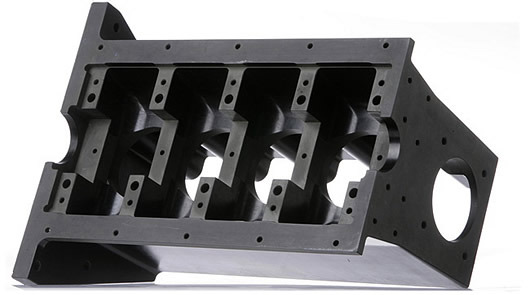For the past century automobile engines have mostly been made of iron, aluminum and steel. However, these days, many new lightweight materials like carbon fiber and thermoplastics are finding their way into new cars. For some, the ultimate use of those weight-saving, yet strong plastic materials would be the ability to build an internal combustion engine almost entirely out of plastic. Now, it looks like that milestone may be rapidly approaching.
Composite Castings LLC and Solvay Specialty Polymers have teamed up to build a functional engine with plastic and carbon-fiber composite components, and they have big plans for it. To say it has taken a long time to develop a durable plastic engine would be an understatement, as Composite Castings along with the AMOCO oil company began working on the project back in 1980. They were able to develop the first composite/plastic engine at that time and it was called the “Polimotor,” or Polymer Motor.
The original Polimotor of the early 80’s incorporated reinforced plastic for the block walls, piston skirts, connecting rods, oil pan and portions of the cylinder head. Of course, the crankshaft, camshaft, piston crowns and combustion chambers still had to be made of iron or aluminum. Matti Holtzberg, president of Composite Castings, wanted to prove the concept worked and purchased a Lola T-616 GT Championship car and went racing with the first Polimotor. The car not only ran well, it scored two third place finishes during the 1984 and 1985 seasons, with only one breakdown recorded. Although the Polimotor generated interest from engineers and the media, the US market was more interested in big V8 engines at the time, and interest (and funding) for the Polimotor faded.
Fast forward to 2016 and Composite Castings along with Solvay Specialty Polymers have declared a renewed interest in the plastic engine project. Holtzberg says the time is right for a plastic engine that offers increased corrosion resistance, less noise and vibration, and of course, a lot less weight. He also claims there is now growing interest from several large automakers. “Our goal is to demonstrate the durability and performance of a plastic engine by using the latest in thermoplastics technology,” says Holtzberg. “At the same time, we want to showcase CO2 reduction technologies, such as turbocharging and electronic water pumps.”
Holtzberg says the new “Polimotor 2” engine will be a turbocharged four-cylinder, double overhead camshaft design that will produce 350 hp at 7,000 rpm. It will also weigh 90 pounds less than a similar metal engine. The polymer chemistries used in Polimotor 2 were not available 30 years ago and today’s new plastics allow many more metal engine components to be replaced with plastic ones.
Along with a reinforced plastic block, the water pump, oil pump, water inlet, throttle body, fuel rail, cam sprockets and other parts will be made of thermoplastic materials in Polimotor 2. Polimotor 2 will not be completely made of plastic of course, as current technology dictates that metal is still used for the combustion chambers, cylinder bores, crankshaft and flywheel. Interestingly, the use of plastic allows epoxies and other types of adhesives to be used to assemble many of the components and Holtzberg says “I see a day in the near future when cylinder heads will be bonded onto engine blocks.”
Currently, Composite Castings and Solvay Specialty Polymers have plans to install the Polimotor 2 into a road racing-style car and compete at Daytona, Sebring and other road racing circuits later this year. If all goes well, the team hopes to participate in the LeMans 24-hour race in 2017 or 2018. If the lightweight plastic engine concept proves viable on the racetrack, it is probably only a matter of time before thermoplastic engine blocks and other plastic engine components begin appearing on production cars.

